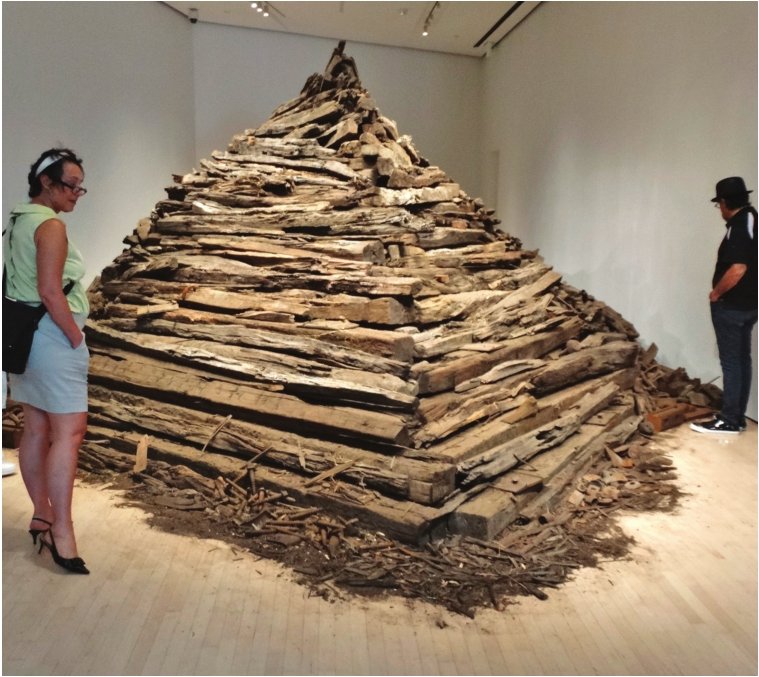
Sooty, sweaty and smelling of creosote, Detroit artist Scott Hocking was out of his element last week at MSU’s ultra-clean, white-walled Broad Art Museum.
But Hocking knew what he was about.
After hauling 15 tons of railroad ties, splintered wood and assorted metal junk and dirt into a firstfloor gallery and assembling it into a looming monument to Michigan’s industrial past, he made the gallery his element.
Hocking is best known for erecting temporary, site-specific sculptures out of found materials in abandoned factories and other sites in his native Detroit. He planted clunky 1970s TVs on top of massive pillars that once held up the Packard Auto plant, as if the TVs were gods, and assembled a giant egg out of marble fragments in Detroit’s Michigan Central Train Station. He made an ark out of a shattered barn in Michigan’s Thumb and did something to an old pickle factory on Detroit’s east side that is beyond my powers of description. He’s done work throughout Michigan and in Europe, and has 10 or 15 projects going on at a time, some of which will take 20 years to complete.
Usually, when Hocking works onsite, he is resigned to the art’s inevitable destruction, so he takes carefully planned photos for exhibit in museums. This time, he brought the mountain to MSU.
The towering ziggurat of worn-out railroad ties, known as “sleepers” in the trade, is surrounded with gears, bolts, nuts, nails and other railroad hardware Hocking found around Lansing. The rusty junk almost bubbles around the prow of the dynamically shaped ziggurat, like spray in front of a battleship.
Hocking cleaned up pretty well for the exhibit opening Saturday, but there was no mistaking his agenda of rubbing one world in the face of another. He calls the sculpture “The Sleeper (Cow-Catcher).”
“Not only the texture and jagged metals and the mess, but the smell — creosote,” Hocking said. “You smell it as soon as you walk in the door. I’m confronting an austere, pristine white box with brutal working-class reality.”
He’s been waiting for a chance to work with railroad ties, a totem of his early youth, ever since he walked along abandoned lines, nosed around in empty buildings and felt low chords of past eras and past civilizations in the stuff left behind.
Hocking said the museum setting didn’t change his modus operandi a bit.
“I think of myself as a site-specific artist —any site, whether it’s an abandoned building, out in the woods. This just happens to be a museum, but the crazy architecture influenced my ideas.”
Hocking’s work floors you with its sheer ambition, seeming simplicity and visual impact, but he’s out to raise questions. What makes a ruin different from a monument? Which splinters of the past are worth preserving? Is there such a thing as progress in civilization or is it just layers of stuff that eventually break apart?
Hocking felt that Lansing’s pre-automobile status as a railroad hub and agricultural center makes “The Sleeper (Cowcatcher)” a natural fit for the Broad.
Land grants were instrumental to the establishment of both MSU and the railroad network that transformed the state in the mid-19th century.
The ties were made of white pine, a part of the old-growth forests that once blanketed the state from shore to shore, treated with a carbon-based chemical called creosote to make them durable.
The artist has a less high-minded connection with MSU, too. He spent a stoner semester at MSU in 1993 before dropping out.
“I was just doing acid and mushrooms and drinking and smoking and selling pot,” he said. But he spent a lot of time in the woods and wandering the tracks south of campus.
“All of that went into my thinking too,” he said.
There were practical hurdles to getting the sculpture into the museum. Hocking negotiated with Conrail to harvest the lumber from a Detroit-area graveyard of over 50,000 ties. MSU Infrastructure Services fumigated the ties for bugs.
Hocking didn’t decide on the battleship-like shape of the ziggurat until he actually started hauling the ties into the narrow, pointy gallery.
“When you’re driving by the museum, the end of the building scoops out in the same way, like a cow-catcher,” he said. “It’s also like a step pyramid, or an overturned vessel.”
Hocking considers himself working-class and doesn’t kowtow to the “art world,” with which he has an uneasy alliance. He wasn’t shy about riffing on the most commonplace remark about the Zaha Hadid-designed Broad Musum.
“It’s like a spaceship traveling through space and time,” he said. “I tell people this is just an 1850s version of that.”
Scott Hocking: Field Station ‘The Sleeper (cow-catcher)’ Aug. 4 – Sept. 30, 2018 MSU Broad Art Museum
Support City Pulse - Donate Today!
Comments
No comments on this item Please log in to comment by clicking here